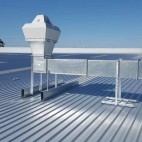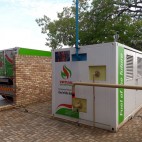Energy efficiency is one of South Africa's greatest challenges complemented by the need for an affordable, sustaibable energy supply. The most practical and immediate route to success is not the building of new power generating plants, but the use of less energy from the national grid.
Eskom has long called for a voluntary 10% reduction by users to assist with the balance of electricity supply and demand, particularly at peak periods. It’s the only recourse, as Eskom is unable to offer a ‘quick fix’ to this on-going problem. It will take years for the government-backed utility to commission a sufficient number of new power stations to catch up with the backlogs in supply. A clear indication of South Africans’ belief in the ‘use less Eskom-supplied energy’ dictum was the unprecedented interest in solar power - nature’s free alternative – for domestic, commercial and industrial applications in 2015.
Rooftop solar photovoltaic (PV) power solutions are among the most practical and they’re in use the world over by those looking to act responsibly to boost their energy needs, control of their carbon footprints and minimise harmful emissions. In SA, concerns over power reliability, possible load-shedding and looming electricity price hikes – as opposed to eco-friendliness - have persuaded an increasing number of consumers to opt for solar power which is increasingly seen as an attractive, cost-effective solution, particularly when compared to noisy diesel- or petrol-powered generator options. It is also seen an ideal hedge against electricity price rises which seem inevitable in SA.
Sustainable buildings
As consumers from all sectors of the economy show their determination to reduce their reliance on Eskom, so South African architects are realising the benefits associated with designing buildings that follow energy-saving guidelines for this new generation of buyers. Architects are being called up to design ‘green’ or sustainable buildings for residential, commercial and industrial use. Solar power is seen as an ideal complement to the classical building design goals of economy, utility, durability and comfort. There are countless ways for solar PV to be developed and optimised in future. Many are sure to lead to new architectural concepts - in combination with other types of renewable energy resources.
That said, there are a number of pitfalls to dodge when it comes to selecting a solar PV solution. For example, while small-scale systems are increasingly sold in hardware stores and builders’ supply depots, users should resist the temptation to effect a DIY installation. Although most roofs can support the added weight of a solar energy system, some can’t. It takes a professional – preferably a structural engineer - to check the condition of the rafters and assess the capability of the roof to safely support the added dead load of the solar array, the mounting rack and the temporary live load imposed by the installation crew. (Unsurprisingly, the latter calculation is often omitted by DIY’ers.)
At the core of any solar PV system are its solar panels or ‘modules’. Choosing an appropriate solar PV system to meet specific needs can be a technically challenging exercise particularly when it comes to matching off-take with system capacity demands. It is also challenging because there are so many differing standards of solar PV modules on the market, ranging from the ‘cheap-and-nasty’ all the way up to high quality, specialised panels.
Developments in solar technology
Decisions to select solar power as the ‘go-to’ option are increasingly supported by developments in the field of solar technology, including the release of utility grid-connected, hybrid solar PV power systems capable of functioning as back-up rather than complementary power sources in the event of a power outage. These systems can be operated in three modes: linked to the electricity grid (grid-tied); as grid-tied unit with battery backup (in a hybrid configuration); or as a stand-alone hybrid unit. In line with uninterruptible power supply (UPS) and other conventional solutions, switchover time from mains to batteries is a rapid 15 milliseconds.
Mirroring advances in solar PV technology have come breakthroughs in system design and application. South Africa’s Soltra Energy recently released an innovative solution to provide businesses with more effective energy returns from rooftop solar systems. Conventional wisdom maintains that solar PV panels should be orientated towards north in the southern hemisphere to allow for the most efficient power generation. The result, from a power production standpoint, is a ‘bell curve’ reflecting power increases throughout the day peaking at midday and gradually falling again to zero at sunset.
In mid-2015 an iterative evaluation process involving a grid-linked hybrid solar PV application for a Johannesburg-based company was undertaken in which various solar PV system configurations were tested. The tests initially evaluated power production from traditionally north-facing panels. Subsequently, various directions were tried culminating in a convention-breaking east-west configuration. The outcome has proven that a convention-breaking, east-west orientation of solar panels can often be more advantageous for a business application.
The motivation for the tests was an Eskom electrical power supply historically incapable of meeting the business’ full demand. A complementary challenge was also met. This was to reduce the aggregate electricity cost for the facility. The initial goal of the test programme was to match energy production to the measured load profile, while the second objective was to maximise the financial benefit.
For simulations conducted with an equal number of panels and inverters, the east-west configuration showed immediate advantages as it provided power production earlier in the day, with a slightly lower peak. It was thus a better match for the facility’s demand curve (see graph).While a more advantageous match was achieved, concerns were nevertheless raised about the loss of yield. A number of different angles of inclination were subsequently tested and eventually an angle of 20 degrees from the horizontal was chosen as the best compromise between ‘flattening’ the production curve and loss of yield.
It was noted that the east-west installation results in approximately 5% lower installation cost because the brackets and mounting material are used more effectively, while the panel density on the roof can be as much as 30% higher, allowing for a greater energy yield per square metre. When all the factors are taken into account, it is clear that the east-west oriented system is comparable to a north-facing system on a ‘cost of energy’ versus a ‘kilowatts peak (kWp) installed’ basis. (kWp is essentially the rate at which a solar PV installation generates energy at its rated peak performance.)
Furthermore, when the added advantages of over-panelling the inverters at a fraction of the cost of the entire system is maximised, and the lower cost of installation is taken into account, an east-west orientated installation is seen to provide significant advantages – always depending on application and based on desired results. One of the keys to the success of similar installations going forward lies with their management. Sophisticated ‘smart’ power management solutions can now be installed and tailored to users’ needs.
These systems will, for example, complement grid power with solar power when necessary (at peak times), divert excess solar power to possible battery storage for later or after-hours use as appropriate. A range of micro smart-grid solutions that measure the generated solar power on a minute-by-minute basis, compare it to current grid power availability and assess current load states is available. South African expertise in this field has proven that unconventionally-designed solar PV systems will be able to complement grid power when really necessary and provide a solution robust enough to meet business as well as domestic requirement.
Step up in battery storage
SA has also seen a major step up in battery storage technology in recent months. The prevalence of routine load shedding and power outages has exposed one of the Achilles heels of standby power devices. This is the shortened lifespan of energy storage batteries when subjected to full depletion on a regular basis. Arguably as important as the design of the solar PV system itself, batteries need to be correctly specified and then maintained and serviced regularly. It’s vital that every battery storage solution be tailored to the user’s energy requirements, which can vary from one application to another depending on the number of appliances to be supported and the number of solar panels installed. The batteries’ type and construction could also differ.
Battery storage solutions almost always centre on the ‘deep-cycle’ variety. Popular deep-cycle batteries are either sealed lead-acid batteries, or new-generation lithium-ion batteries. Both types are designed to be deeply discharged using a sizable percentage of their capacity. A South African company. Powermode, has designed and developed a purpose-built, long-run battery pack which comprises a number of sealed deep cycle VRLA (Valve Regulated Lead Acid) Absorbed Glass Matt batteries.
This battery-pack’s ‘long run’ attributes are due to ‘smart’ technology built into each pack which is sized according to load. Central to the solution is a battery charger with a computerised battery balancing harness that automatically reports - via the Internet and a ‘cloud-based’ portal - on a wide range of parameters associated with individual batteries in the pack. Data streams including temperature, state of charge, load and depth of discharge are monitored. A tally of the number of discharge/charge cycles is also logged. Should an individual battery’s performance not meet design criteria or fail for any reason it is replaced immediately by a support team in terms of a performance guarantee. The key to battery longevity lies in a thorough understanding of the status of individual batteries. The management of the battery pack not only distributes and balances the load, discharge and charge regimes across all batteries but takes steps to ensure that no battery is compromised through over-cycling. With this in mind, one of the most significant features of the Powermode-supplied battery pack – which can be retro-fitted to existing systems - is its three-year, on-site guarantee – acknowledged as a ‘first’ for the industry.
The Lithium-ion option arrives
Perhaps one of the world’s more memorable advances in the power provisioning field in 2015 was the launch of the Tesla Powerwall. The Tesla Powerwall is a revolutionary concept, but not necessarily because the battery system is based on lithium-ion (Li-ion) technology – which has been around for many years powering cell-phones, lap-top computers and now electric cars. It is revolutionary because it is the first solution that makes it possible for the wide-spread use of alternative energy sources - such as solar PV. If the Tesla Powerwall was seen to be ideally positioned to address the power provisioning problems and challenges faced by South Africans, the news of a locally-designed and manufactured challenger – the Soltra Energy Wall – can be viewed as a game-changer in the local marketplace.Like its American (Tesla) counterpart, the Soltra Energy Wall is designed to store excess energy, whether it is derived from the Eskom grid, from solar panels or a combination of both as found in increasingly common hybrid systems.
The space-saving unit represents a leap forward in battery storage and is expected to boost the acceptance of rooftop solar PV-plus-battery solutions in 2016 and beyond, giving SA consumers greater control over their energy usage.The Soltra system is ideally suited to meeting the power provisioning challenges faced by South African businesses and individuals on a regular basis – load-shedding and power-outages caused by any number of factors, including cable theft. These issues are not commonly experienced in the US where the ‘green lobby’ is more assertive as a technology driver.
Time-of-day billing
South Africans will increasingly have to deal with regular hikes in the price of electricity and will soon face the introduction of time-of-day billing (or ‘smart-metering’) which will further increase costs. Eskom is in the process of installing smart meters that will effectively boost the price of electricity at peak times. With the lowest rates being charged in the middle of the night – when demand is low - and high rates in the morning and afternoon/early evening - when demand is at its peak – it will make increasing economic sense to store energy in batteries in off-peak times and consume it in peak times. It’s even better if the energy storage is boosted by solar PV during the day. These inevitabilities will underpin the broad acceptance of the Soltra Energy Wall concept as a cost-effective, efficient and professionally-supported alternative. The Soltra battery can be charged from the grid during off-peak periods, supplemented by solar energy, or it can form the basis of an off-grid installation, relying entirely on solar PV/alternative energy sources.
‘Grid parity’, the moment when a rooftop solar PV system makes economic sense, has been achieved in parts of Europe. It can’t be that far off in South Africa where it can be expected to disrupt business models across the electrical industry and provide a sizable boost to the renewable energy market. As a result, many industry-watchers expect demand for solar solutions to break all records in SA 2016, particularly in the light of Eskom’s proposed tariff hikes.
Against this backdrop, efficient battery storage could quickly become one of the biggest advances in the South African energy landscape, which will continue to be characterised by a mismatch between demand and supply. What’s needed now is for government to throw its weight behind rooftop solar PV initiatives as they would help to create thousands of new jobs, establish many new small businesses and upskill hundreds of technicians on a long-term, sustainable basis. According to estimates, there is a sizable market with potential for growth for solar PV installations in SA. Sales of this many systems could well help create many new small-scale businesses and hundreds of thousands of new jobs in the near term. Let’s not ignore the strides that have been made locally and overseas in solar PV implementation and look forward the many innovations that are in the pipe-line relating to this technology.










